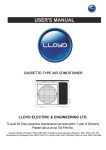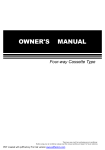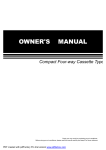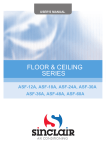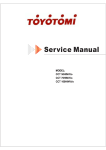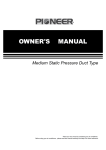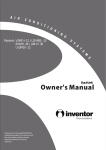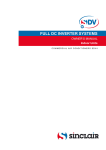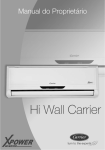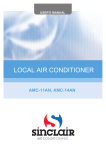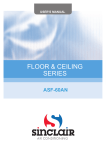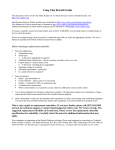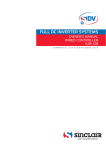Download user manual - sinclair air conditioners
Transcript
USER'S MANUAL UNI ON/OFF SERIES ASC-60AN „Original instruction“ INDOOR UNIT OUTDOOR UNIT Fig.1 Air flow louver(at air outlet) Air-in grill Drain pump(drain water from indoor unit) Display panel Drain pipe Remote controller Air outlet Refrigerant pipe Air filter(inside air-in grill) Air inlet Air inlet Air outlet NOTE All the pictures in this manual are for explanation purpose only. They may be slightly different from the air conditioner you purchased(depend on model).The actual shape shall prevail. 1. IMPORTANT SAFETY INFORMATION To prevent injury to the user or other people and property damage, the following instructions must be followed. Incorrect operation due to ignoring of instructions may cause harm or damage. The safety precautions listed are divided into two categories. In either case, important safety information is listed which must be read carefully. WARNING Failure to observe a warning may result in death. The appliance shall be installed in accordance with national wiring regulations. CAUTION Failure to observe a caution may result in injury or damage to the equipment. WARNING Ask your dealer for installation of the air conditioner. Incomplete installation performed by yourself may result in a water leakage, electric shock, and fire. Ask your dealer for improvement, repair, and maintenance. Incomplete improvement, repair, and maintenance may result in a water leakage, electric shock, and fire. In order to avoid electric shock, fire or injury, or if you detect any abnormality such as smell of fire, turn off the power supply and call your dealer for instructions. Never let the indoor unit or the remote controller get wet. It may cause an electric shock or a fire. Never press the button of the remote controller with a hard, pointed object. The remote controller may be damaged. Never replace a fuse with that of wrong rated current or other wires when a fuse blows out. Use of wire or copper wire may cause the unit to break down or cause a fire. It is not good for your health to expose your body to the air flow for a long time. Do not insert fingers, rods or other objects into the air inlet or outlet. When the fan is rotating at high speed, it will cause injury. Never use a flammable spray such as hair spray, lacquer or paint near the unit. It may cause a fire. Never touch the air outlet or the horizontal blades while the swing flap is in operation. Fingers may become caught or the unit may break down. Never put any objects into the air inlet or outlet. Objects touching the fan at high speed can be dangerous. Never inspect or service the unit by yourself. Ask a qualified service person to perform this work. Do not dispose this product as unsorted municipal waste. Collection of such waste separately for special treatment is necessary. Do not dispose of electrical appliances as unsorted municipal waste, use separate collection facilities. Contact you local government for information regarding the connection systems available. If electrical appliances are disposed of in landfills or dumps, hazardous substances can leak into the groundeater and get into the food chain, damaging your health and well-being. To prevent refrigerant leak, contact your dealer. When the system is installed and runs in a small room, it is required to keep the concentration of the refrigerant, if by any chance coming out, below the limit. Otherwise, oxygen in the room may be affected, resulting in a serious accident. The refrigerant in the air conditioner is safe and normally does not leak. If the refrigerant leaks in the room, contact with a fire of a burner, a heater or a cooker may result in a harmful gas. Turn off any combustible heating devices, ventilate the room, and contact the dealer where you purchased the unit. Do not use the air conditioner until a service person confirms that the portion where the refrigerant leaks is repaired. CAUTION Do not use the air conditioner for other purposes. In order to avoid any quality deterioration, do not use the unit for cooling precision instruments, food, plants, animals or works of art. Before cleaning, be sure to stop the operation, turn the breaker off or pull out the supply cord. Otherwise, an electric shock and injury may result. In order to avoid electric shock or fire, make sure that an earth leak detector is installed. Be sure the air conditioner is grounded. In order to avoid electric shock, make sure that the unit is grounded and that the earth wire is not connected to gas or water pipe, lightning conductor or telephone earth wire. In order to avoid injury, do not remove the fan guard of the outdoor unit. Do not operate the air conditioner with a wet hand. An electric shock may happen. Do not touch the heat exchanger fins. These fins are sharp and could result in cutting injuries. Do not place items which might be damaged by moisture under the indoor unit. Condensation may form if the humidity is above 80%, the drain outlet is blocked or the filter is polluted. After a long use, check the unit stand and fitting for damage. If damaged, the unit may fall and result in injury. To avoid oxygen deficiency, ventilate the room sufficiently if equipment with burner is used together with the air conditioner. Arrange the drain hose to ensure smooth drainage. Incomplete drainage may cause wetting of the building, furniture etc. 2. PARTS NAMES The air conditioner consists of the indoor unit, the outdoor unit, the connecting pipe and the remote controller. (See Fig.1) Function indicators on indoor unit display panel Temporary button Infrared signal receiver Never touch the internal parts of the controller. Do not remove the front panel. Some parts inside are dangerous to touch, and a machine trouble may happen. Never expose little children, plants or animals directly to the air flow. Adverse influence to little children, animals and plants may result. Do not allow a child to mount on the outdoor unit or avoid placing any object on it. Falling or tumbling may result in injury. Do not operate the air conditioner when using a room fumigation - type insecticide. Failure to observe could cause the chemicals to become deposited in the unit, which could endanger the health of those who are hypersensitive to chemicals. Do not place appliances which produce open fire in places exposed to the air flow from the unit or under the indoor unit. It may cause incomplete combustion or deformation of the unit due to the heat. Do not install the air conditioner at any place where flammable gas may leak out. If the gas leaks out and stays around the air conditioner, a fire may break out. The appliance is not intended for use by young children or infirm persons without supervision. This appliance can be used by children aged from 8 years and above and persons with reduced physical, sensory or mental capabilities or lack of experience and knowledge if they have been given supervision or instruction concerning use of the appliance in a safe way and understand the hazards involved. Children shall not play with the appliance. Cleaning and user maintenance shall not be made by children without supervision. This appliance is not intended for use by persons (including children) with reduced physical, sensory or mental capabilities, or lack of experience and knowledge, unless they have been given supervision or instruction concerning use of the appliance by a person responsible for their safety. Children should be supervised to ensure that they do not play with the appliance. If the supply cord is damaged, it must be replaced by the manufacturer, its service agent or similarly qualified persons in order to avoid a hazard. Operation lamp Timer indicator Alarm indicator PRE-DEF indicator(cooling and heating type) or fan only indicator(cooling only type) Display panel Fig.2-1 This function is used to operate the unit temporarily in case you misplace the remote controller or its batteries are exhausted. Two modes including AUTO and FORCED COOL can be selected through the TEMPORARY BUTTON on the air-in grill control box of the indoor unit. Once you push this button, the air conditioner will run in such order: AUTO, FORCED COOL, OFF, and back to AUTO. 1 AUTO The OPERATION lamp is lit, and the air conditioner will run under AUTO mode. The remote controller operation is enabled to operate according to the received signal. 2 FORCED COOL The OPERATION lamp flashes, the air conditioner will turn to AUTO after it is enforced to cool with a wind speed of HIGH for 30 minutes. The remote controller operation is disabled. 3 OFF The OPERATION lamp goes off. The air conditioner is OFF while the remote controller operation is enabled. 3. AIR CONDITIONER OPERATIONS AND PERFORMANCE Use the system in the following temperature for safe and effective operation. The Max operation temperature for the air conditioner (Cooling/Heating). Temperature/ Mode Outdoor temperature Room temperature Cooling operation 18°C ~ 43°C 17°C ~ 32°C Heating operation -7°C ~ 24°C 0°C ~ 30°C Dry operation 18°C ~ 43°C 17°C ~ 32°C Do not operate your air conditioner in a wet room such as a bathroom or laundry room. Table 3-2 NOTE 1 If air conditioner is used outside the above conditions, it may cause the unit to function abnormally. 2 The phenomenon is normal that the surface of air conditioning may condense water when the relative larger humidity in room, please close the door and window. 3 Optimum performance will be achieved within these operating temperature range. disconnect the power to save energy. Keep the indoor unit and remote controller at least 1 m away from televisions, radios, stereos, and other similar equipment. Failing to do so may cause static or distorted pictures. A dirty air filter will reduce cooling or heating efficiency, please clean it once two weeks. 5. ADJUSTING AIR FLOW DIRECTION While the unit is in operation, you can adjust the air flow louver to change the flow direction and naturalize the room temperature evenly. Thus you can enjoy it more comfortably. ■ Three-minute protection feature A protection feature prevents the air conditioner from being activated for approximately 3 minutes when it restarts immediately after operation. ■ Power failure Power failure during operation will stop the unit completely. • The OPERATION lamp on the indoor unit will start flashing when power is restored. • To restart operation, push the ON/OFF button on the remote controller. • Lightning or a car wireless telephone operating nearby may cause the unit to malfunction. Disconnect the unit with the power and then connect the unit with the power again. Push the ON/OFF button on the remote controller to restart operation. ■ Refrigerant Leakage Detection(optional): With this new technology, the display area will appear EC (if applicable) and the LED indication lamps continue flashing when the outdoor unit detects refrigerant leakage. ■ Louver Angle Memory Function(optional): For some models, the machine is special designed with louver angle memory function. Power failure during operation or pressing the ON/OFF button on the remote controller will stop the unit completely. When the power restores or pressing the ON/OFF button on the remote controller again, the unit restarts automatically with the previous open angle of the horizontal louver by the memory function. So we strongly recommend that the open angle of the horizontal louver should not be set too small, in case the condensed water forms and drops from the horizontal louver. Press the Manual control button and the open angle of the horizontal louver will be restored to the standard angle. 4. HINTS FOR ECONOMICAL OPERATION The following should be noticed to ensure an economical operation. Adjust the air flow louver properly and avoid direct air flow to room inhabitants. Adjust the room temperature properly for a comfortable environment. Avoid excessive heating or cooling. Prevent direct sunlight during cooling operation by using curtains or blinds. Ventilate often. Extended use requires special attention to ventilation. Keep doors and windows closed. If the doors and windows remain open, air will flow out of your room causing a decrease in the cooling or heating effect. Never place objects near the air inlet or the air outlet of the unit. It may cause deterioration in the effect or stop the operation. Set the timer . If you don't plan to use the unit for a long time, please take the batteries from the remote controller. When the power is on, some energy will be consumed, even if the air conditioner isn't in operation. So please Adjust it up and down Fig 5-1 Adjust it up and down Fig 5-2 ■ Set the air flow direction. Press the SWING button to adjust the louver to the desired position and press this button again to maintain the louver at this position. ■ Adjust the air flow direction automatically. Press the SWING button, the louver will swing automatically. While this function is set, the swing fan of indoor unit runs; otherwise, the swing fan doesn't run. The swing scale of every side is 30°. When the air conditioner isn't in operation (including when TIMER ON is set), the SWING button will be invalid. 6. MAINTENANCE CAUTION Before you clean the air conditioner, be sure the power supply is off. Check if the wiring is not broken off or disconnected. Use a dry cloth to wipe the indoor unit and remote controller. A wet cloth may be used to clean the indoor unit if it is very dirty. Never use a damp cloth on the remote controller. Do not use a chemically-treted duster for wiping or leave such material on the unit for long. it may damage or fade the surface of the unit. Do not use benzine, thinner, polishing powder, or similar solvents for cleaning. These may cause the plastic surface to crack or deform. ■ Maintenance after a long stop period (eg. at the beginning of the season) Check and remove everything that might be blocking inlet and outlet vents of indoor units and outdoor units. Clean air filters and casings of indoor units. Refer to "Cleaning the air filter" for details on how to proceed and make sure to install cleaned air filters back in the same position. Turn on the power at least 12 hours before operating the unit in order to ensure smoother operation. As soon as he power is turned on, the remote controller displays appear. ■ Maintenance before a long stop period (eg. at the end of the season) Let the indoor units run in fan only operation for about half a day in order to dry the interior of the units. Clean air filters and casings of indoor units. Refer to " Cleaning the air filter" for details on how to proceed and make sure to install cleaned air filters back in the same position. Fig.6-3 ■ Cleaning the air filter The air filter can prevent the dust or other particulate from going inside. In case of blockage of the filter, the working efficiency of the air conditioner may greatly decrease . Therefore, the filter must be cleaned once two weeks during long time usage. If the air conditioner is installed in a dust place, clean the air filter frequent. If the accumulated dust is too heavy to be cleaned, please replace the filter with a new one(replaceable air filter is an optional fitting). 1 Open the air-in grill Push the grill switches towards the middle simultaneously as indicated in Fig.6-1. Then pull down the air-in grill. The control box cables ,which are originally connected with the main body electrical terminators must be pulled off before doing as indicated above. 2 Take out the air-in grill (together with the air filter shown in (Fig.6-1). Pull the air-in grill down at 45 and lift it up to take out the grill. 3 Dismantle the air filter. 4 Clean the air filter Vacuum cleaner or pure water may be used to clean the air filter. If the dust accumulation is too heavy , please use soft brush and mild detergent to clean it and dry out in cool place. •The air-in side should face up when using vacuum cleaner. (See Fig. 6-3) •The air-in side should face down when using water. (See Fig. 6-4) CAUTION Do not dry out the air filter under direct sunshine or with fire. 5 Re-install the air filter. 6 Install and close the air-in grill in the reverse order of step 1 and 2 and connect the control box cables to the corresponding terminators of the main body . Fig.6-4 7. FOLLOWING SYMPTOMS CONDITIONER TROUBLES ARE NOT AIR Symptom 1: The system does not operate ■ The air conditioner does not start immediately after the ON/OFF button on the romote controller is pressed. If the operation lamp lights, the system is in normal condition.To prevent overloading of the compressor motor, the air conditioner starts 3 minutes after it is turned ON. ■ If the operation lamp and the "PRE-DEF indicator(cooling and heating type) or fan only indicator(cooling only type)" light, it means you choose the heating model, When just starting, if the compressor has not started, the indoor unit appears "anti cold wind" protection because of its overlow outlet temperature. Symptom 2: Change into the fan mode during cooling mode ■ In order to prevent the indoor evaporator frosting, the system will change into fan mode automatically, restore to the cooling mode after soon. ■ When the room temperature drops to the set temperature, the compressor goes off and the indoor unit changes to fan mode; when the temperature rises up, the compressor starts again. It is same in the heating mode. Symptom 3: White mist comes out of a unit Symptom 3.1: Indoor unit ■ When humidity is high during cooling operation If the interior of an indoor unit is extremely contaminated, the temperature distribution inside a room becomes uneven. It is necessary to clean the interior of the indoor unit. Ask your dealer for details on cleaning the unit. This operation requires a qualified service person Fig.6-1 Fig.6-2 Symptom 3.2: Indoor unit, outdoor unit ■ When humidity is high during cooling operation If the interior of an indoor unit is extremely contaminated, the temperature distribution inside a room becomes uneven. It is necessary to clean the interior of the indoor unit. Ask your dealer for details on cleaning the unit. This operation requires a qualified service person. ■ When the system is changed over to heating operation after defrost operation Moisture generated by defrost becomes steam and is exhausted. Symptom 4: Noise of air conditioners cooling Symptom 4.1: Indoor unit ■ A continuous low "shah" sound is heard when the system is in cooling operation or at a stop. When the drain pump (optional accessories) is in operation,this noise is heard. ■ A "pishi-pishi" squeaking sound is heard when the system stops after heating operation. Expansion and contraction of plastic parts caused by temperature change make this noise. Symptom 4.2: Indoor unit, outdoor unit ■ A continuous low hissing sound is heard when the system is in operation. This is the sound of refrigerant gas flowing through both indoor and outdoor units. A continuous low hissing sound is heard when the system is in operation. This is the sound of refrigerant gas flowing through both indoor and outdoor units. ■ A hissing sound which is heard at the start or immediately after stopping operation or defrost operation. This is the noise of refrigerant caused by flow stop or flow change. Symptom 4.3: Outdoor unit ■ When the tone of operating noise changes. This noise is caused by the change of frequency. Symptom 5: Dust comes out of the unit ■ When the unit is used for the first time in a long time. This is because dust has gotten into the unit. NO. Malfunction running lamp 1 In-outdoor unit communication checking channel is abnormal 2 Room temperature sensor checking channel is abnormal 3 4 5 6 7 8 9 10 Evaporator sensor malfunction Outdoor unit low pressure malfunction Quick-flash 11 Lifting panel communication checking channel is abnormal Quick-flash 12 13 14 Lifting panel malfunction Symptom 6: The units can give off odors ■ The unit can absorb the smell of rooms, furniture, cigarettes, etc., and then emit it again. Symptom 7: The outdoor unit fan does not spin. ■ During operation. The speed of the fan is controlled in order to optimize product operation. 8. TROUBLESHOOTING 8.1 Troubles and causes of air conditioner If one of the following malfunctions occur, stop operation, shut off the power, and contact with your dealer. ■ The operation lamp is flashing rapidly (5Hz). This lamp is still flashing rapidly after turn off the power and turn on again. (See in Table 8-1) ■ Remote controller receives malfunction or the button does not work well. ■ A safety device such as a fuse, a breaker frequently actuates. ■ Obstacles and water enter the unit. ■ Water leaks from indoor unit. ■ Other malfunctions. If the system does not properly operate except the above mentioned cases or the above mentioned malfunctions is evident, investigate the system according to the following procedures. (See in Table 8-2) 8.2 Troubles and causes of remote controller Before asking for serving or repairing, check the following points. (See in Table 8-3) timer lamp Quick-flash defrosting lamp Quick-flash E2 Quick-flash E3 Quick-flash Water pump temperature sensor Outdoor malfunction Quick-flash Quick-flash EEPROM malfunction Quick-flash Quick-flash Quick-flash Quick-flash Lifting panel is not closed Quick-flash Quick-flash E4 Quick-flash E5 Quick-flash E6 Quick-flash E8 Quick-flash Eb E7 Water-level alarm malfunction DC motor speed out of control display (nixie tube) E1 Quick-flash Condenser sensor malfunction Refrigerant leakage detection malfunction alarm lamp Quick-flash Ed Quick-flash Quick-flash F0 Quick-flash Quick-flash Quick-flash F1 On Quick-flash Quick-flash F2 Quick-flash EC Table 8-1 Symptoms Causes Solution Unit does not start • Power failure. • Power switch is off. • Fuse of power switch may have burned. • Batteries of remote controller exhausted or other problem of controller. • W ait for the comeback of power. • Switch on the power. • Replace the fuse. • Replace the batteries or check the controller. Air flowing normally but completely can't cooling • Temperature is not set correctly. • Be in 3 minutes protection of compressor. • Set the temperature properly. • Wait. Units start or stop frequently Low cooling effect Low heating effect Symptoms • Refrigerant is too little or too much. • Airor no concreting gas in the refrigerating circuit. • Compressor is malfunction. • Voltage is too high or too low. • System circuit is blocked. • Outdoor unit and indoor unit heat exchanger is dirty. • The air filter is dirty. • Inlet/outlet of indoor/outdoor units is blocked. • Doors and windows are open • Sunlight directly shine. • Too much heat resource. • Outdoor temp. is too high. • Leakage of refrigerant or lack of refrigerant. • Outdoor temperature is lower than 7°C . • Doors and windows not completely closed. • Leakage of refrigerant or lack of refrigerant. Causes • Check whether the MODE indicated on the display is "AUTO" The fan speed can not be changed. The remote controller signal is not transmitted even when the ON/OFF button is pushed. The TEMP. indicator does not come on. • Check whether the MODE indicated on the display is "DRY" • Check leakage, and rightly recharge refrigerant. • Vacuum and recharge refrigerant. • Maintenance or change compressor. • Install manostat. • Find reasons and solution. • Clean the heat exchanger. • Clean the air filter. • Eliminate all dirties and make air smooth. • Close doors and windows. • Make curtains in order to shelter from sunshine. • Reduce heat source. • AC cooling capacity reduces (normal). • Check leakage and rightly recharge refrigerant. • Use heating device. • Close doors and windows. • Check leakage and rightly recharge refrigerant. Table 8-2 Solution When the automatic mode is selected, the air conditioner will automatically change the fan speed. When dry operation is selected, the air conditioner automatically change the fan speed. The fan speed can be selected during "COOL" , "FAN ONLY", and "HEAT". • Check whether the batteries in the remote controller are exhausted. The power supply is off. • Check whether the MODE indicated on the display is FAN ONLY The temperature cannot be set during FAN mode. The indication on the display disappears after a lapse of time. • Check whether the timer operation has come to an end when the TIMER OFF is indicated on the display. The air conditioner operation will stop up to the set time. The TIMER ON indicator goes off after a lapse of certain time. • Check whether the timer operation is started when the TIMER ON is indicated on the display. Up to the set time, the air conditioner will automatically start and the appropriate indicator will go off. No receiving tone sounds from the indoor unit even when the ON/OFF button is pressed. • Check whether the signal transmitter of the remote controller is properly directed to the infrared signal receiver of the indoor unit when the ON/OFF button is pressed. Directly transmit the signal transmitter of the remote controller to the infrared signal receiver of the indoor unit, and then repeatly push the ON/OFF button twice. Table 8-3 AIR CONDITIONER REMOTE CONTROLLER Thank you very much for purchasing our air conditioner. Please read this owner's manual carefully before using your air conditioner. The design and specifications are subject to change without prior notice for product improvement. Consult with the sales agency or manufacturer for details. pressing and sliding off. (2) Remove the old batteries and insert the new batteries, placing the(+) and (-) ends correctly. (3) Reattach the cover by sliding it back into position. NOTE: When the batteries are removed, the remote controller erases all programming. After inserting new batteries, the remote controller must be reprogrammed. CAUTION Handling the remote controller Location of the remote controller. • Use the remote controller within a distance of 8 meters from the appliance, pointing it towards the receiver. Reception is confirmed by a beep. • Do not mix old and new batteries or batteries of a different type. Do not leave the batteries in the remote controller if it is not going to be used for 2 or 3 months. • Dispose of the old batteries in the special containers to be found in the sales outlets. Remote Controller Specifications Model Rated Voltage CAUTION • The air conditioner will not operate if curtains, doors or other materials block the signals from the remote controller to the indoor unit. • Prevent any liquid from falling into the remote controller. Do not expose the remote controller to direct sunlight or heat. • If the infrared signal receiver on the indoor unit is exposed to direct sunlight, the air conditioner may not function properly. Use curtains to prevent the sunlight from falling on the receiver. • If other electrical appliances react to the remote controller, either move these appliances or consult your local dealer. ______________________________________ Replacing batteries The remote controller is powered by two dry batteries(R03/LR03X2) housed in the rear part and protected by a cover. (1) Remove the cover by RG51C/(C)E, RG51C/BG(C)E. 3.0V(Dry batteries R03/LR03×2) Lowest Voltage of CPU Emitting Signal 2.0V Signal Receiving Range 8m (when using 3.0 voltage, it gets 11m) Environment -5O°C~60°C Performance Feature 1. Operating Mode: AUTO, COOL, DRY, HEAT (Cooling & heating models only) and FAN. 2. Timer Setting Function in 24 hours. 3. Indoor Setting Temperature range: 17OC~30OC. 4. Full function of LCD (Liquid Crystal Display) Note: • Buttons design might be slightly different from the actual one you purchased depending on individual models. • All the functions described are accomplished by the indoor unit. If the indoor unit has no this feature, there is no corresponding operation happened when press the relative button on the remote controller. Function buttons TEMP UP Button Push this button to increase the indoor temperature setting in 1°C increments to 30°C. TEMP DOWN Button Push this button to decrease the indoor temperature setting in 1°C increments to 17°C. MODE Button Each time the button is pressed, the operation mode is selected in the sequence of the following: NOTE: Heat mode is for Cooling & Heating models only. SWING Button Used to stop or start horizontal louver movement. The louver will swing up and down automatically if push this button. AIR DIRECTION Button Used to set the desired up/down air flow direction. The louver changes 6 degree in angle for each press. SWING Button Used to stop or start vertical louver movement . NOTE: This button only available when the remote controller is used with corresponding unit. RESET Button Once the recessed RESET button is pressed, all of the current settings will be cancelled and the controller will return to the initial settings. ON/OFF Button Operation starts when this button is pressed and stops when the button is pressed again. FAN SPEED Button Used to select the fan speed in four steps: FAN SPEED Button+ MODE Button Press the Mode and Fan speed button simultaneously for 2 seconds. The remote controls into faceplate setting state and the LCD shows F2.Press the TEMP UP( ) to control the faceplate up and press the TEMP DOWN( ) to control the faceplate down. Press any button to exit the faceplate setting state, then the LCD back to the normal display. TIMER ON Button Press this button to activate the Auto-on time setting. Each press will increase the time setting in 30 minutes increments, up to 10 hours, then at 1 hour increments up to 24 hours. To cancel the Auto-on time setting, just press the button until the time setting is 0.0. ECO Button Select this function during the sleeping time. It can maintain the most comfortable temperature and save energy. This function is available on COOL, HEAT or AUTO mode only . NOTE: While the unit is running under Energy-saving mode, it would be cancelled if press MODE, FAN SPEED or ON/OFF button. TIMER OFF Button Press this button to activate the Auto-off time setting. Each press will increase the time setting in 30 minutes increments, up to 10 hours, then at 1 hour increments up to 24 hours. To cancel the Auto-off time setting, just press the button until the time setting is 0.0. LOCK Button Press this recessed button to lock all current settings, and the remote controller will not accept any operation except that of the LOCK. Use the LOCK mode when you want to prevent settings from being changed accidentally. Press the LOCK button again to cancel the LOCK function. A lock symbol will appear on the remote controller display when the lock function is activated. Indicators on LCD MODE display Displays the current selected mode. Including AUTO, COOL, DRY, HEAT(cooling & heating models only) and FAN. Transmission Indicator This transmission indicator will light when remote controller transmits signals to the indoor unit. Temp./Timer display The temperature setting (from 17OC to 30OC) or timer setting (0~24h) will be displayed. If FAN mode is selected, there will be no display. ON/OFF display This indicator will be displayed when the unit is operating. MODE display(FAN mode) FAN SPEED display Displays the selected fan speed: AUTO, HIGH, MED(if applicable) and LOW. Nothing displays when the fan speed is selected in AUTO speed. When AUTO or DRY Mode is selected, there will be no signals displayed. TIMER display This display area shows the settings of the TIMER. That is, if only the Autoon time function is set, it will display TIMER ON. If only the Auto-off time function is set, it will display TIMER OFF. If both functions are set, it will display TIMER ON OFF which indicates you have chosen both the Auto-on time and Auto-off time. LOCK Indicator LOCK display is displayed when pushing the LOCK button. Push the LOCK button to clear display. How to use the buttons Auto operation Ensure the unit is plugged in and power is available. The OPERATION indicator on the display panel of the indoor unit illuminates. 1. Press the MODE button to select Auto. 2. Press the TEMP button to set the desired temperature. The temperature can be set within a range of 17O C~ 30O C in 1OC increments. 3. Press the ON/OFF button to start the air conditioner. NOTE 1. In the Auto mode, the air conditioner can logically choose the mode of Cooling, Fan, Heating and Dehumidifying by sensing the difference between the actual ambient room temperature and the set temperature on the remote controller. 2. In the Auto mode, you can not switch the fan speed. It has already been automatically controlled. 3. If the Auto mode is not comfortable for you , the desired mode can be selected manually. Cooling/ Heating/ Fan operation Ensure the unit is plugged in and power is available. 1. Press the MODE button to select COOL, HEAT, (cooling & heating models only) or FAN mode. 2. Press the TEMP button to set the desired temperature. The temperature can O O O be set within a range of 17 C~ 30 C in 1 C increments. 3. Press the FAN SPEED button to select the fan speed in four steps- Auto, Low, Med, or High. 4. Press the ON/OFF button to start the air conditioner. NOTE In the FAN mode, the setting temperature is not displayed in the remote controller and you are not able to control the room temperature either. In this case, only step 1, 3 and 4 may be performed. Dehumidifying operation Ensure the unit is plugged in and power is available. The OPERATION indicator on the display panel of the indoor unit illuminates. 1. Press the MODE button to select DRY mode. 2. Press the TEMP button to set the desired temperature. The temperature can be set within a range of 17°C~ 30°C in 1°C increments. 3. Press the ON/OFF button to start the air conditioner. NOTE In the Dehumidifying mode, you can not switch the fan speed. It has already been automatically controlled. Dehumidifying volume is 5 L/h Swing operation Use the DIRECTION/SWING button to adjust the horizontal louver, use the SWING button to adjust the vertical louver. 1. Press the SWING or ( ) button, the horizontal or vertical louver will swing automatically. when press the AIR DIRECTION button, the louver changes 6 degree in angle for each press. NOTE: When the louver swing or move to a position which would affect the cooling and heating effect of the air conditioner, it would automatically change the swing/ moving direction. Timer operation Press the TIMER ON button can set the auto-on time of the unit. And press the TIMER OFF button can set the auto-off time of the unit. To set the Auto-on time. 1. Press the TIMER ON button. The remote controller shows TIMER ON, the last Auto-on setting time and the signal "h" will be shown on the LCD display area. Now it is ready to reset the Auto-on time to START the operation. 2. Push the TIMER ON button again to set desired Auto-on time. Each time you press the button, the time increases in 30 minutes increments, up to 10 hours, then at 1 hour increments up to 24 hours. 3. After setting the TIMER ON, there will be a one-half second delay before the remote controller transmits the signal to the air conditioner. Then, after approximately another 2 seconds, the signal "h" will disappear and the set temperature will re-appear on the LCD display window. To set the Auto-off time. 1. Press the TIMER OFF button. The remote controller shows TIMER OFF, the last Auto-off setting time and the signal "h" will be shown on the LCD display area. Now it is ready to reset the Auto-off time to START the operation. 2. Push the TIMER OFF button again to set desired Auto-off time. Each time you press the button, the time increases in 30 minutes increments, up to 10 hours, then at 1 hour increments up to 24 hours. 3. After setting the TIMER OFF , there will be a one-half second delay before the remote controller transmits the signal to the air conditioner. Then, after approximately another 2 seconds, the signal "h" will disappear and the set temperature will re-appear on the LCD display window. IMPORTANT The effective operation time set by the remote controller for the timer function is limited to the following settings: 0.5, 1.0, 1.5, 2.0, 2.5, 3.0, 3.5, 4.0, 4.5, 5.0, 5.5, 6.0, 6.5, 7.0, 7.5, 8.0, 8.5, 9.0, 9.5, 10, 11, 12, 13, 14, 15, 16, 17, 18, 19, 20, 21, 22, 23 and 24. Example of Timer setting TIMER ON (Auto-on Operation) The TIMER ON feature is useful when you want the unit to turn on automatically before you return home. The air conditioner will automatically start operating at the set time. Example: To start the air conditioner in 6 hours. 1. Press the TIMER ON button, the last setting of starting operation time and the signal "h" will show on the display area. 2. Press the TIMER ON button to display "6:0h" on the TIMER ON display of the remote controller. 3. Wait for about 3 seconds and the digital display area will show the temperature again. Now this function is activated. TIMER OFF (Auto-off Operation) The TIMER OFF feature is useful when you want the unit to turn off automatically after you go to bed. The air conditioner will stop automatically at the set time. Example: To stop the air conditioner in 10 hours. 1. Press the TIMER OFF button, the last setting of stopping operation time and the signal "h" will show on the display area. 2. Press the TIMER OFF button to display "10h" on the TIMER OFF display of the remote controller. 3. Wait for about 3 seconds and the digital display area will show the temperature again. Now this function is activated. COMBINED TIMER (Setting both ON and OFF timers simultaneously) TIMER OFF → TIMER ON (On → Stop → Start operation) This feature is useful when you want to stop the air conditioner after you go to bed, and start it again in the morning when you wake up or when you return home. Example: To stop the air conditioner 2 hours after setting and start it again 10 hours after setting. 1. Press the TIMER OFF button. 2. Press the TIMER OFF button again to display 2.0h on the TIMER OFF display. 3. Press the TIMER ON button. 4. Press the TIMER ON button again to display 10h on the TIMER ON display . 5. Wait for the remote control to display the setting temperature. TIMER ON -TIMER OFF (Off -* Start -* Stop operation) This feature is useful when you want to start the air conditioner before you wake up and stop it after you leave the house. Example: To start the air conditioner 2 hours after setting, and stop it 5 hours after setting. 1. Press the TIMER ON button. 2. Press the TIMER ON button again to display 2.0h on the TIMER ON display. 3. Press the TIMER OFF button. 4. Press the TIMER OFF button again to display 5.0h on the TIMER OFF display . 5. Wait for the remote control to display the setting temperature. CAUTION • The timer setting(TIMER ON or TIMER OFF) that in sequence occurs directly after the set time will be activated first. ECO operation The ECO function enables the unit to automatically increase(cooling) or decrease (heating) 1OC per hour for the first two hours, then hold steady for the next 5 hours, after that the unit will stop operation. It can maintain the most comfortable temperature and save energy. NOTE: The ECO function is only available under Cooling, Heating and AUTO operation. ELECTRIC SCHEMATIC DIAGRAM ASC-60AN indoor unit ASC-60AN outdoor unit RATING LABEL FOUR-WAY CASSETTE TYPE AIR CONDITIONER SPLIT UNIVERSAL AIR CONDITIONER OUTDOOR UNIT INDOOR MODEL ASC-60AN OUTDOOR MODEL ASC-60AN COOLING CAPACITY 14.9kW REFRIGERANT R410A/3500g HEATING CAPACITY 17.0kW EXCESSIVE OPERATING PRESSURE DISCHARGE 4.2MPa SUCTION 1.5MPa EXCESSIVE OPERATING PRESSURE DISCHARGE 4.2MPa SUCTION WEIGHT(OUTDOOR) 111.1kg 1.5MPa WEIGHT(INDOOR) 28.3kg POWER SOURCE 380-415V 3N~ 50Hz POWER SOURCE 220-240V~ 50Hz 1Ph RATED CURRENT 19.0A RATED CURRENT 1.0A RATED INPUT 7000W RATED INPUT 150W OUTDOOR UNIT RESISTANCE CLASS IP 24 ENERGY LABEL Energy Air-Conditioner Manufacturer ASC-60AN ASC-60AN More efficient Outside Unit Inside Unit ASF-60AN ASF-60AN More efficient A B C D E F G A B C D E F G E Less efficient C Less efficient Annual energy consumption, kWh in cooling mode (Actual consumption will depend on how the appliance is used and climate) kW Cooling output Energy efficiency ratio 3015 14.95 2.48 Annual energy consumption, kWh in cooling mode (Actual consumption will depend on how the appliance is used and climate) kW Cooling output Energy efficiency ratio Full load (the higher the better) 2685 15.24 2.84 Full load (the higher the better) Cooling only Type Cooling only Cooling + Heating Cooling + Heating Air cooled Air cooled Water cooled Water cooled Heat output kW Heating Performance A: higher Air-Conditioner Manufacturer Outside Unit Inside Unit Type Energy G: lower Noise 17 A B C D E Heat output F G A: higher 55 kW Heating Performance G: lower Noise (dB(A) re 1 pW) (dB(A) re 1 pW) Further information is contained in product brochures Further information is contained in product brochures Norm EN 14511 Air-conditioner Energy Label Directive 2002/31/EC Norm EN 14511 Air-conditioner Energy Label Directive 2002/31/EC 16.74 A B C D 55 E F G NOTE CONCERNING PROTECTION OF ENVIRONMENT This product must not be disposed of via normal household waste after its service life, but must be taken to a collection station for the recycling of electrical and electronic devices. The symbol on the product, the operating instructions or the packaging indicate such disposal procedures. The materials are recyclable in accordance with their respective symbols. By means of re-use, material recycling or any other form of recycling old appliances you are making an important contribution to the protection of our environment. Please ask your local council where your nearest disposal station is located. INFORMATION CONCERNING USED REFRIGERANT MEDIUM This unit is containing fluorinated gases included in the Kyoto protocol. The maintanance and the liquidation must be carried out by qualified personel. Type of refrigerant: R410A The composition of the cooling medium R410A: (50% HFC-32, 50% HFC-125) The quantity of the refrigerant: please see the unit label. The value GWP: 2088 GWP = Global Warming Potential In case of quality problem or other please contact your local supplier or authorized service center. Emergency number: 112 PRODUCER Producer: SINCLAIR CORPORATION Ltd., 1-4 Argyll St., London W1F 7LD, UK, www.sinclair-eu.com This product was manufactured in China (Made in China). REPRESENTATIVE, TECHNICAL SUPPORT NEPA spol. s r.o. Purkyňova 45 612 00 Brno Czech Republic Tel.: +420 541 590 140 Fax: +420 541 590 124 www.nepa.cz [email protected]




















